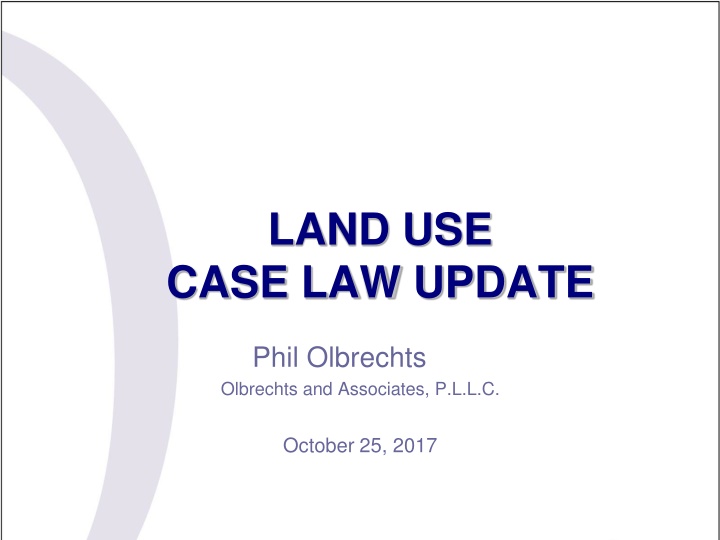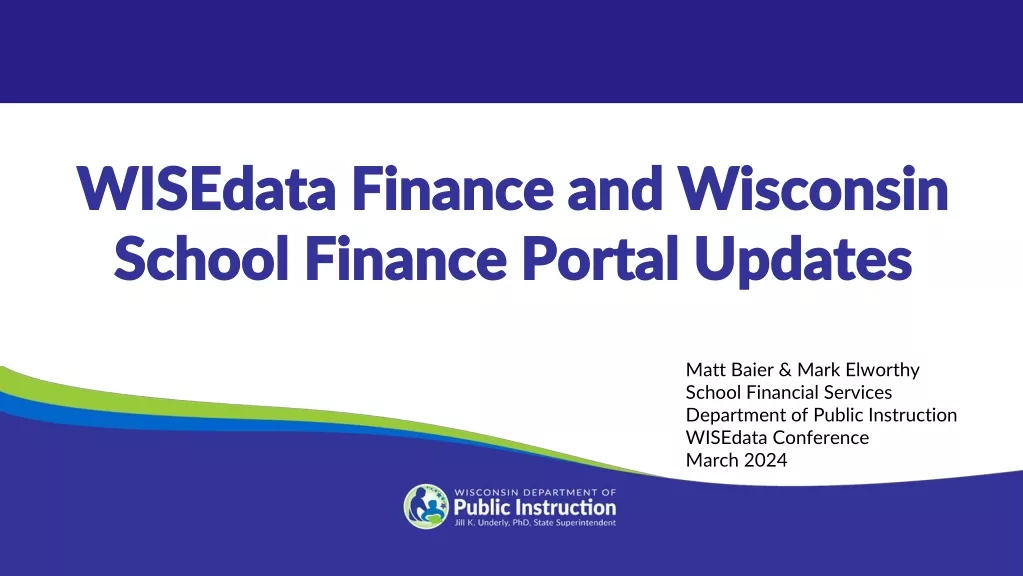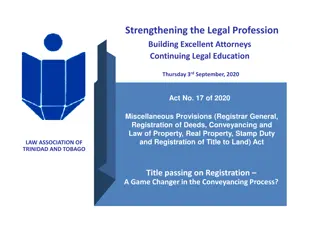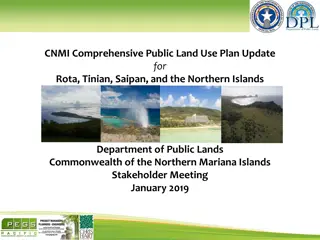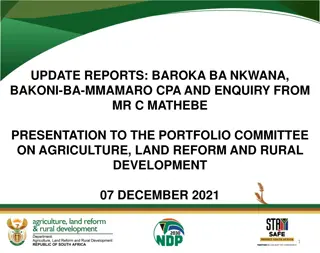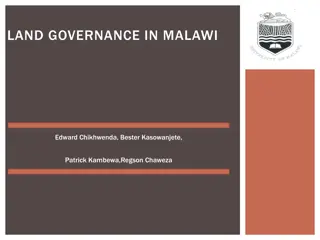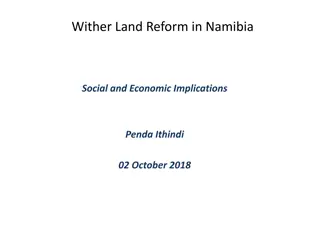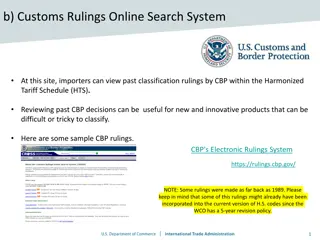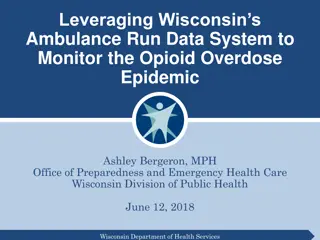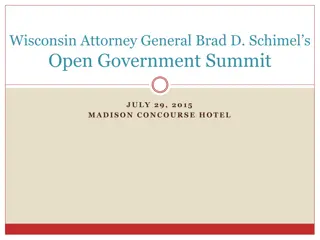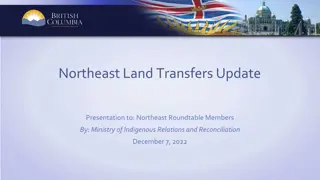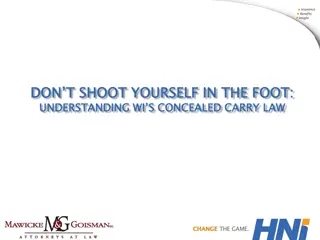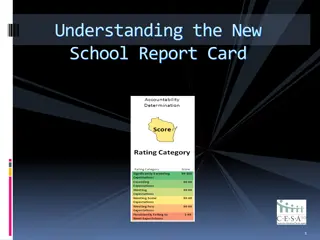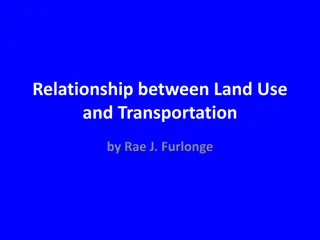Land Use Case Law Update - Key Rulings and Facts of Murr v. Wisconsin
Key rulings and facts from the Murr v. Wisconsin case, including discussions on the Lot Combination Rule in Wisconsin, the property ownership by the Murrs along the St. Croix River, and the regulatory background leading to the case. Important points such as the unit of measurement in takings and its relevance to adjoining lots are highlighted.
Download Presentation

Please find below an Image/Link to download the presentation.
The content on the website is provided AS IS for your information and personal use only. It may not be sold, licensed, or shared on other websites without obtaining consent from the author.If you encounter any issues during the download, it is possible that the publisher has removed the file from their server.
You are allowed to download the files provided on this website for personal or commercial use, subject to the condition that they are used lawfully. All files are the property of their respective owners.
The content on the website is provided AS IS for your information and personal use only. It may not be sold, licensed, or shared on other websites without obtaining consent from the author.
E N D
Presentation Transcript
LAND USE CASE LAW UPDATE Phil Olbrechts Olbrechts and Associates, P.L.L.C. October 25, 2017
Some Gross Oversimplifications: Murr US Supreme Court Rules Wisconsin Lot Combination Rule Doesn t Create Takings. 1 2. Snohomish County NPDES vesting condition Not Subject to State Vested Rights Doctrine. Maytown Sand and Gravel Politically Based Land Use Decisions = big liability. 3. Whatcom (Hirst) County comprehensive plans must protect quantity and quality of groundwater. 4. Schnitzer City initiated rezones not subject to LUPA 5. Chumbley 21 day LUPA appeal deadline doesn t stop challenges outside scope of building permit approval. 6. Columbia Riverkeeper A port can approve a lease for a major development project before completion of an EIS if the lease has sufficient escape clauses 7. Cave Latecomer agreement approvals subject to LUPA 8.
Unit of Measurement Murr v. Wisconsin, 582 U.S. __ (2017) Key Rulings: Wisconsin s Lot Combination Rule Didn t Exact a Takings on Petitioners Property Under the right circumstances, the unit of measurement for a takings isn t confined to a single lot.
Unit of Measurement Murr v. Wisconsin, 582 U.S. __ (2017) Facts: Regulatory Background: - Wisconsin DNR adopts rules pursuant to the federal Wild and Scenic Rivers combinations along the St. Croix River to protect river resources. - The lot combination rule requires adjoining lots in common ownership to be combined unless they each have at least one acre of land suitable for development - The DNR rule required localities to adopt the same provision, which was adopted by St. Croix County - The lot combination rule was adopted in 1976 Act that required lot
Unit of Measurement Murr v. Wisconsin, 582 U.S. __ (2017) Facts: The Murrs -Four Murr siblings came into ownership of adjoining lots along the St. Croix River. -The parents of the siblings bought the two adjoining lots at two different times and subsequently conveyed them to the siblings on different dates. -The parents bought the first lot, Lot F, in 1960 and built a cabin on it. In 1961 the parents transferred Lot F to their plumbing company. They purchased the second lot, Lot E, in 1963 and kept Lot E in their name. -Lot F was conveyed to the Murrs in 1994 and Lot E in 1995
Unit of Measurement Murr v. Wisconsin, 582 U.S. __ (2017) Facts: The lots - The lots have the same topography. A steep bluff cuts through the middle of each, with level land suitable for development above the bluff and next to the water below it. - Each lot is approximately 1.25 acres in size, but because of the waterline and the steep bank they each have less than one acre of land suitable for development with a combined 0.98 acres of developable land.
Unit of Measurement Murr v. Wisconsin, 582 U.S. __ (2017) Facts: The Merger - Around 2005 the siblings became interested in moving the cabin on Lot F to a different portion of the lot and selling Lot E to fund the project. - The siblings were advised of the lot merger and attempted to get a variance, which was denied by the St. Croix Board of Adjustment - The siblings allege a takings and lose all the way up the Wisconsin state judicial system. Petition granted to US Supreme Court.
Unit of Measurement Murr v. Wisconsin, 582 U.S. __ (2017) Facts: The Impact - Government appraisals showed value of Lots E and F as separate developable lots to total $771,000. As merged, the value only dropped to $698,000. Lot F by itself was worth $373,000. - Siblings submit counterfactual appraisal that if Lot E were sold as an undevelopable lot, it would only be worth $40,000.
Unit of Measurement Murr v. Wisconsin, 582 U.S. __ (2017) Law: The Takings Clause of the Fifth Amendment provides property shall not be taken for public use, without just compensation. that private
Unit of Measurement Murr v. Wisconsin, 582 U.S. __ (2017) Law: Regulatory Taking: Compensation can be required for more than just physical appropriation. Regulatory takings were first recognized in the 1922 case of Pennsylvania Coal Co. v. Mahon, 260 US 393, where the court ruled that while property may be regulated to a certain extent, if regulation goes too far it will be recognized as a taking. Regulatory Takings Complex and fact specific: This area of the law has been characterized by ad hoc, factual inquiries, designed to allow careful examination and weighing of all the relevant circumstances.
Unit of Measurement Murr v. Wisconsin, 582 U.S. __ (2017) Law: Regulatory Taking Categorical threshold: - With limited exceptions, a law that denies all economically beneficial or productive use is a taking. Beyond the threshold balancing public need verses private burden: - If value is left a takings may still occur based upon a complex of factors including: (1) the economic impact of the regulation on the claimant; (2) the extent to which the regulation has interfered with distinct investment-backed expectations; and (3) the character of the governmental action.
Unit of Measurement Murr v. Wisconsin, 582 U.S. __ (2017) Issue Presented: What is the proper unit of property against which to assess the effect of the challenged governmental action? Specifically for the Murrs, when looking at the impact on them, do you look at the reduction in value and use of Lot E, or the combination of Lots E and F?
Unit of Measurement Murr v. Wisconsin, 582 U.S. __ (2017) Precedents Regarding Units: Court historically doesn t just single out part of property affected by regulation and then declare total takings: Penn Central Transp. Co. v. New York City, 438 U.S. 104 (1978) Impacts of historic preservation ordinance prohibiting office tower on top of Penn Central station were assessed as to impact to value of property as a whole as opposed to just air rights above station. Tahoe Sierra Preservation Council, Inc. v. Tahoe Regional Planning Agency, 535 U.S. 302 (2002) Effects of 32 month moratorium not just based upon 32 month period but upon overall impact on development prospects.
Unit of Measurement Murr v. Wisconsin, 582 U.S. __ (2017) How to Determine Unit: [N]o single consideration.. can be used to set the unit. A number of factors must be considered, including: 1. 2. 3. 4. the treatment of the land under state and local law; the physical characteristics of the land; the prospective value of the regulated land; whether reasonable expectations about property ownership would lead a landowner to anticipate that his holdings would be treated as one parcel, or, instead, as separate tracts. The inquiry is objective, and the reasonable expectations at issue derive from background customs and legal tradition
Unit of Measurement Murr v. Wisconsin, 582 U.S. __ (2017) Getting Murr Specific: Court rejects approach of both Wisconsin and the Murrs: Wisconsin: State law always sets the unit of measurement in this case the lot combination rule merged the lots so when doing takings analysis Lots E and F should be combined, i.e. it s just a 10% reduction in value! Murrs: Lots matter and lot lines always set the unit! The value of Lot E is reduced to almost nothing because of the lot combination rule.
Unit of Measurement Murr v. Wisconsin, 582 U.S. __ (2017) Getting Murr Specific: Court attacks Murr rationale: 1. Lot combination/merger ordinances is a legitimate exercise of government power, as reflected by its consistency with a long history of state and local merger regulations that originated nearly a century ago. 2. Merger provisions often form part of a regulatory scheme that establishes a minimum lot size in order to preserve open space while still allowing orderly development. 3. Relying on lot lines only would frustrate municipalities' ability to implement minimum lot size regulations by casting doubt on the many merger provisions that exist nationwide today
Unit of Measurement Murr v. Wisconsin, 582 U.S. __ (2017) Getting Murr Specific: Court applies its factors for assigning unit as combined lots: 1. Effects of restrictions lot merger requirements have legitimate state purpose in protecting river, consistent with widespread understanding that lot lines are not dominant or controlling in every case. The restrictions were also voluntarily assumed since the lots transferred ownership after adoption of the combination rule. 2. Physical Characteristics of Property The lots are long and narrow with limited development potential. sensitive river where environmental regulations should be anticipated. 3. Value of Lot E to F: Combining the lots strongly mitigates against the reduction in value to E by enhancing the value of F. Privacy and recreational space is increased, as are options for building sites. They are along a
Unit of Measurement Murr v. Wisconsin, 582 U.S. __ (2017) Getting Murr Specific: With unit regarded as combined lot, there clearly is not regulatory taking: 1. No categorical takings Murrs have not been deprived of all economically beneficial use. Burden on Property Owner Minor - Value reduced by less than 10%. No big investment backed expectations Murrs acquired ownership after lot combination rule was adopted they knew this was coming. Nature of government action Combination rule was a reasonable land-use regulation, enacted as part of a coordinated federal, state, and local effort to preserve the river and surrounding land. 2. 3. 4.
Vested Rights and the Feds Snohomish County v. Pollution Control Hearings Board, 187 Wash.2d 346 (2016) Train Wreck Not Avoided Ruling: NPDES vesting scheme not subject to Washington s vested rights doctrine because its based upon state and federal mandates as opposed to local regulations.
Vested Rights and the Feds Snohomish County v. Pollution Control Hearings Board, 187 Wash.2d 346 (2016) Facts (Regulatory Background): The federal Clean Water Act (CWA) prohibits any discharge of pollutants into the nation's waters, unless the discharge is made according to the terms of a permit issued under the National Pollution Discharge Elimination System (NPDES). 33 U.S.C. 1311(a), 1342. The federal Environmental Protection Agency (EPA) may issue NPDES permits, but it may also delegate the authority to issue permits to a state agency. 33 U.S.C. 1342(a)(1), (b). In Washington, EPA has delegated the authority to issue NPDES permits to Ecology. See RCW 90.48.260.
Vested Rights and the Feds Snohomish County v. Pollution Control Hearings Board, 187 Wash.2d 346 (2016) Facts (DOE Issues NPDES Permit): In August 2012, Ecology issued the 2013 2018 Phase I Municipal Stormwater Permit. The 2013 2018 Permit authorizes and regulates the discharge of stormwater to surface waters and to ground waters from large and medium municipal separate storm sewer systems. Snohomish County, King County, Pierce County, Clark County, and the cities of Seattle and Tacoma are among the entities that are permittees under the 2013 2018 Permit. The 2013 2018 Permit is effective from August 1, 2013 through July 31, 2018.
Vested Rights and the Feds Snohomish County v. Pollution Control Hearings Board, 187 Wash.2d 346 (2016) Facts (NPDES Permit): The 2013 2018 Permit requires all permittees to create a stormwater management program. That program must include the enactment of local ordinances or other governing documents regulating development within each permittee's jurisdiction. The 2013 2018 Permit requires several conditions that permittees must implement through their ordinances. Condition S5.C.5 is one such condition.
Vested Rights and the Feds Snohomish County v. Pollution Control Hearings Board, 187 Wash.2d 346 (2016) Facts (NPDES Permit Condition S5.C.5.): Condition S5.C.5 includes a lengthy set of minimum performance measures that vary according to type of development, including preparing stormwater site plans; drafting stormwater pollution prevention plans; maintaining natural drainage patterns to the maximum extent practicable; and implementing on-site stormwater management best management practices to the extent feasible, constructing stormwater treatment facilities to treat stormwater runoff, implementing flow control standards to reduce the impacts of stormwater runoff, ensuring that projects draining into wetlands comply with various guide sheets and construction restrictions, and maintaining an operation and maintenance manual.
Vested Rights and the Feds Snohomish County v. Pollution Control Hearings Board, 187 Wash.2d 346 (2016) Facts (The Problem): Train Wreck: NPDES Permit Condition S5.C.5a.iii: The local program adopted to meet the requirements of S5.C.5.a.i through ii shall apply to all applications submitted after July 1, 2015 and shall apply to projects approved prior [to] July 1, 2015, which have not started construction by June 30, 2020
Vested Rights and the Feds Snohomish County v. Pollution Control Hearings Board, 187 Wash.2d 346 (2016) Facts (The Problem): Train Wreck for Phase II Eastern Permits (not addressed in opinion): NPDES Permit Condition S5.C.4a.iii: The local program adopted to meet the requirements of S5.B.5.a.ii(a) and (b)(2) below shall apply to all applications1 submitted after December 31, 2017 and shall apply to projects approved prior to January 1, 2018, which have not started construction by December 31, 2023
Vested Rights and the Feds Snohomish County v. Pollution Control Hearings Board, 187 Wash.2d 346 (2016) Issue: Does Condition S5.C.5aiii violate the vested rights doctrine by applying to permits that vested prior to the adoption of local stormwater ordinances required by the condition?
Vested Rights and the Feds Snohomish County v. Pollution Control Hearings Board, 187 Wash.2d 346 (2016) What is the vested rights doctrine? The vested rights doctrine generally provides that certain land development applications must be processed under the land use regulations in effect when the application was submitted, regardless of subsequent changes to those regulations. Development rights vest on a date certain when a complete development application is submitted. The purpose of the vested rights doctrine is to provide certainty to developers and to provide some protection against fluctuating land use policy.
Vested Rights and the Feds Snohomish County v. Pollution Control Hearings Board, 187 Wash.2d 346 (2016) What permits are subject to the vested rights doctrine? Building permits Subdivisions Development Agreements
Vested Rights and the Feds Snohomish County v. Pollution Control Hearings Board, 187 Wash.2d 346 (2016) What exactly do these permits vest to? RCW application shall be considered under the building permit ordinance in effect at the time of application, and the zoning or other land use control ordinances in effect on the date of application. 19.27.095(1): valid and complete building permit RCW 58.17.033(1) provides that a proposed division of land shall be considered under the subdivision or short subdivision ordinance, and zoning or other land use control ordinances, in effect on the land at the time a fully completed application for preliminary plat approval of the subdivision, or short plat approval of the short subdivision, has been submitted to the appropriate county, city, or town official.
Vested Rights and the Feds Snohomish County v. Pollution Control Hearings Board, 187 Wash.2d 346 (2016) What exactly do these permits vest to? RCW 36.70B.180 provides that a development agreement is not subject to an amended or new zoning ordinance or development standard or regulation adopted after the effective date of the agreement.
Vested Rights and the Feds Snohomish County v. Pollution Control Hearings Board, 187 Wash.2d 346 (2016) So building/subdivision/development agreement vests against NPDES permit requirements requirements qualify as more precisely, issue of whether is whether NPDES other land use control ordinances under building and subdivision vesting statutes, or development standard under developer agreement statute.
Vested Rights and the Feds Snohomish County v. Pollution Control Hearings Board, 187 Wash.2d 346 (2016) What is a land use control ordinance ? This is where Supreme Court departs from Court of Appeals Analysis Term undefined by legislature, so court looks to legislative history. Senate bill report noted that vesting statutes were based upon early vesting case law, which in turn were directed at controlling local discretion.
Vested Rights and the Feds Snohomish County v. Pollution Control Hearings Board, 187 Wash.2d 346 (2016) Ogden suggests that once a developer's rights vest, local ordinances must apply to all developers alike. Our more recent precedent supports this proposition, noting that the vested rights doctrine is rooted in notions of fundamental fairness. The legislature's reliance on Ogden thus suggests that the legislature understood the vested rights doctrine as curbing local discretion where none was warranted. 187 Wn.2d at 364.
Vested Rights and the Feds Snohomish County v. Pollution Control Hearings Board, 187 Wash.2d 346 (2016) Also compelling to court was fact that vesting statutes require ordinances to specify what s necessary for a complete application, but SEPA information is not included and original version of proposed statute expressly prohibited SEPA information from being included in information required for complete application. This suggests that legislature didn t consider state requirements to be subject to vesting.
Vested Rights and the Feds Snohomish County v. Pollution Control Hearings Board, 187 Wash.2d 346 (2016) Also note WAC not mentioned in opinion: WAC 197-11-660 (a) Mitigation measures or denials shall be based on policies, plans, rules, or regulations formally designated by the agency (or appropriate legislative body, in the case of local government) as a basis for the exercise of substantive authority and in effect when the DNS or DEIS is issued. (emphasis added)
Vested Rights and the Feds Snohomish County v. Pollution Control Hearings Board, 187 Wash.2d 346 (2016) A final compelling point on legislative intent is fact that legislature adopted statutes indicating acceptance of the Phase II vesting condition. The legislature amended RCW 90.48.260 to dictate that DOE implement the Phase II permit, which includes the vesting condition. The Final Bill Report expressly acknowledged that the Phase II permit had timeframes for implementation, which is a reference to the vesting condition. The legislature then appropriated funds to facilitate the implementation of the Phase II permit.
Vested Rights and the Feds Snohomish County v. Pollution Control Hearings Board, 187 Wash.2d 346 (2016) Second Holding: Finality doesn t apply Finality = if appeal period lapses, permit no longer subject to challenge. Without analysis, Court states that vested rights and finality are closely related and that it agrees with Pollution Control Board that finality doesn t apply to water quality requirements developed under both state and federal law.
Vested Rights and the Feds Snohomish County v. Pollution Control Hearings Board, 187 Wash.2d 346 (2016) Don t Forget: Ruling only directly validates NPDES vesting scheme. Eastern WA Phase II vesting scheme = stormwater regulations apply to permits vested under prior stormwater standards if construction doesn t start by December 31, 2023. NPDES permits only apply to a limited number of Eastern Washington cities and counties identified in next slide
Vested Rights and the Feds Snohomish County v. Pollution Control Hearings Board, 187 Wash.2d 346 (2016) Phase II Cites Phase II Counties Phase II county permits apply to urban areas around permitted cities. Asotin Clarkston East Wenatchee Ellensburg Kennewick Moses Lake Pasco Pullman Richland Selah Spokane Valley Sunnyside Union Gap Walla Walla Wenatchee West Richland Yakima Asotin County Chelan County Douglas County Spokane County Walla Walla County Yakima County
Vested Rights and the Feds Snohomish County v. Pollution Control Hearings Board, 187 Wash.2d 346 (2016) Questions: What about stormwater ordinances not mandated by NPDES permits? What about shoreline and GMA updates? What about new GMA critical area mandates? But on May 2 Supreme Court adds footnote: Our conclusion with respect to the 2013 Phase I Permit should not be interpreted to suggest that all federal- and state-directed environmental laws are exempt from vesting
Burien II The $$$ Sequel Maytown Sand and Gravel LLC v. Thurston County, 198 Wn. App. 560 (2017) In Short: Stick to the Code Land Use Decisions that Appear to be Based Upon Political instead of Code Based Reasons Will Cost you $$$$$$. Court of Appeals sustains 12 million dollar judgment in favor of gravel pit owner and Port of Tacoma.
Burien II The $$$ Sequel Maytown Sand and Gravel LLC v. Thurston County, 198 Wn. App. 560 (2017) Facts: The SUP -- In 2006 Thurston County issues 20 year special use permit to Port of Tacoma for gravel pit operation that included a condition requiring five year review by hearing examiner. -- Condition 6 required adherence to groundwater monitoring plan, condition 6A required verification of off-site supply wells within a year and condition 6 C required installation of 17 monitoring wells within 60 days. Port didn t comply with deadlines.
Burien II The $$$ Sequel Maytown Sand and Gravel LLC v. Thurston County, 198 Wn. App. 560 (2017) Facts: Maytown Sand and Gravel (MSG) -- In 2009 MSG meets with County staff to discuss SUP in anticipation of purchasing gravel pit. County advises that SUP was still valid but that minor staff approvals and things needed to be done. Also advised that all revisions could be handled administratively and that MSG could be mining within 30-60 days. -- MSG enters purchase and sale agreement for gravel pit for $17 million.
Burien II The $$$ Sequel Maytown Sand and Gravel LLC v. Thurston County, 198 Wn. App. 560 (2017) Well, actually: .-- In December, 2009 County emails MSG to let them know there are actually some compliance issues with the SUP conditions and that staff could approve minor amendments, but the hearing examiner had to approve major amendments. -- In February, 2010, County sends MSG a memo finding that needed amendments could be reviewed administratively and that project was in substantial compliance with SUP -- In April, 2010 MSG closes on the purchase and sale agreement for the gravel pit.
Burien II The $$$ Sequel Maytown Sand and Gravel LLC v. Thurston County, 198 Wn. App. 560 (2017) Veering off course: .-- After closing in April, MSG requested eight amendments to the SUP, including condition 6. Specifically, MSG requested an amendment of the missed deadlines in conditions 6A and 6C and the elimination of the background testing required in condition 6C. -- In its February, 2010 memo, the County had identified the amendments to Condition 6 deadlines as minor administrative amendments. -- Now County responds that hearing examiner review required and that new SEPA had to be done. According to the MSG attorney, the County s new position was directed by the attorney for the Board of County Commissioners. -- Hearing examiner approves amendments in April, 2011.
Burien II The $$$ Sequel Maytown Sand and Gravel LLC v. Thurston County, 198 Wn. App. 560 (2017) On to the Five Year Review: --SUP requires hearing examiner review every five years to review permit status --In 2010, County issues a summary report pending the five year review. The report concludes that because no land disturbing activity had yet occurred, the new 2009 critical area ordinance (CAO) should apply. --The County took this same position before the Hearing Examiner at the five year review hearing. The report stated that complying with the new critical area ordinance would likely reduce the mining area, potentially by 100 acres. --In a decision issued in December, 2011, the hearing examiner concludes that new CAO doesn t apply and that the CAO conclusions reached in issuance of SUP still held.
Burien II The $$$ Sequel Maytown Sand and Gravel LLC v. Thurston County, 198 Wn. App. 560 (2017) Appeal of the Five Year Review: --Two environmental groups appeal decision to County Board of County Commissioners (BOCC) -- Two of the three BOCC members were members and donors of one of the environmental groups that appealed. -- BOCC directed staff to evaluate whether permit was still considered active or valid because it hadn t been mined yet. BOCC usually didn t direct staff on permitting issues. --Each BOCC member conducted private meetings with the chair of one of the environmental groups to discuss the SUP and the gravel pit. After learning of the environmental group s position on the SUP, one of the BOCC members expressed interest in re-opening SEPA.
Burien II The $$$ Sequel Maytown Sand and Gravel LLC v. Thurston County, 198 Wn. App. 560 (2017) Just gets worse: --Another BOCC member signed a petition to rezone part of the MSG --At the appeal hearing in March, 2011, none of the BOCC members disclose their meetings with the chair of the environmental group or their membership in the other environmental group --BOCC remands review back to examiner, directing that he review a supplemental habitat plan to determine whether any critical areas were on the gravel pit property under the 2002 CAO and if so, requiring the site plan to be amended to exclude critical areas. .
Burien II The $$$ Sequel Maytown Sand and Gravel LLC v. Thurston County, 198 Wn. App. 560 (2017) MSG Attacks: --MSG judicially appeals BOCC decision under Land Use Petition Act and also seeks damages. --Superior Court reinstates hearing examiner five year review decision by granting a summary judgment motion in favor of MSG. --MSG damages claims handled separately. .
